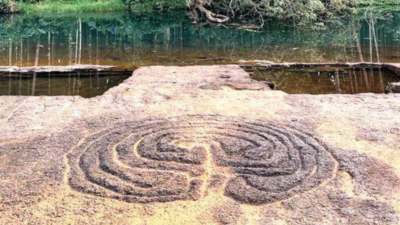Top Searches
Goa, Maharashtra begin first-ever holistic study of Konkan region rock art

There are four known rock carving sites in Goa of which two sites— Pansaimol and Kazur in Sanguem—have been notified as protected sites
PANAJI: For the first time ever a detailed study of the petroglyphs and geoglyphs in Goa and the Konkan belt is being carried out by archaeologists of Goa and Maharashtra. “The area has probably one of the largest concentrations of rock art with nearly 100 sites that have survived thousands of years,” said assistant superintendent archaeologist, directorate of archaeology, Varad Sabnis.
These rock carvings, which are petroglyphs or geoglyphs on horizontal laterite surfaces, depict the life of the early prehistoric farming community. The extensive survey will see experts also explore if there are more carvings outside known areas.
Experts from the Indian Institute of Science Education and Research, Mohali, the Indian numismatic, historical and cultural research foundation, Nashik, and the Nalanda University, Bihar, will provide recommendations on conservation strategy, establishing a chronology and dating.
“The evidence of the experts will also help find out associated prehistoric cultures,” Sabnis said.
There are four known rock carving sites in Goa of which two sites — Pansaimol and Kazur in Sanguem — have been notified as protected sites. The sites at Baoliachem Mudd at Quepem and Mauz at Sattari are yet to be notified. To preserve this prehistoric treasure trove the directorate of archaeology and museums, Maharashtra, and the directorate of archaeology, Goa have proposed that the sites be notified as protected areas.
“Two sites have already made it to Unesco’s tentative list of world heritage sites,” Sabnis said adding, “Goa and Maharashtra will be submitting a joint proposal to declare sites in the Konkan and Goa as rock art hotspots. In this region we have found rock art of different styles, time periods, showcasing different cultural patterns.”
Once notified, the sites get legal protection from damage and development within a 100m radius of these sites, and these will be regulated. Since March 2022, the department has deployed security guards toprotect the sites.
These rock carvings, which are petroglyphs or geoglyphs on horizontal laterite surfaces, depict the life of the early prehistoric farming community. The extensive survey will see experts also explore if there are more carvings outside known areas.
Experts from the Indian Institute of Science Education and Research, Mohali, the Indian numismatic, historical and cultural research foundation, Nashik, and the Nalanda University, Bihar, will provide recommendations on conservation strategy, establishing a chronology and dating.
“The evidence of the experts will also help find out associated prehistoric cultures,” Sabnis said.
There are four known rock carving sites in Goa of which two sites — Pansaimol and Kazur in Sanguem — have been notified as protected sites. The sites at Baoliachem Mudd at Quepem and Mauz at Sattari are yet to be notified. To preserve this prehistoric treasure trove the directorate of archaeology and museums, Maharashtra, and the directorate of archaeology, Goa have proposed that the sites be notified as protected areas.
“Two sites have already made it to Unesco’s tentative list of world heritage sites,” Sabnis said adding, “Goa and Maharashtra will be submitting a joint proposal to declare sites in the Konkan and Goa as rock art hotspots. In this region we have found rock art of different styles, time periods, showcasing different cultural patterns.”
Once notified, the sites get legal protection from damage and development within a 100m radius of these sites, and these will be regulated. Since March 2022, the department has deployed security guards toprotect the sites.
Start a Conversation
FOLLOW US ON SOCIAL MEDIA
FacebookTwitterInstagramKOO APPYOUTUBE









